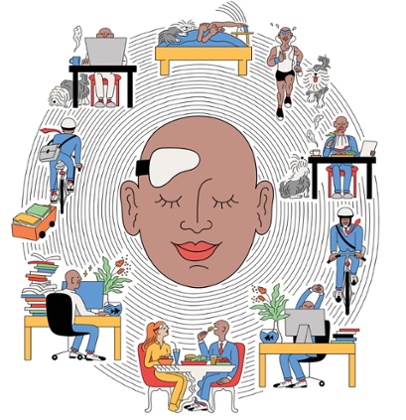
At the San Francisco consciousness hacking monthly meet-up, about 150 personal development geeks are crowding around hi-tech consumer devices that promise a more relaxed you. There is a brain stimulator called Thync, released in June, that applies an electric current to the head to deliver calming vibes, and a breath-monitoring device that looks like a stone, called Spire, that alerts you if you have failed to take a deep breath recently.
There is also a virtual reality meditation environment called Harmony, which its developer would love to commercialise, where a user puts on goggles to help with their chakra visualisation. Conversations bubble up. “I tried meditation but I never really got there and gave up,” says Richard, an IT specialist on a quest to improve his quality of life through technology and science. “What tech do you use to help you?”
Many in California were early adopters of mindfulness practices like mediation and yoga and nowhere is this truer than the San Francisco Bay Area with its history of flowering the 1960s counter-cultural movement and drawing different immigrant populations to create interesting new fusions. The quest to be in the right state of mind is a prevalent trend. And it has spilled over into the tech industry, particularly as peer-reviewed studies have shown such practices can provide profound benefits. Facebook has a meditation room, Google has a Jolly Good Fellow on staff whose job is to enlighten minds, start-ups hold mindfulness retreats and a large Wisdom 2.0 conference unites the movement, even if cynics say it is simply to squeeze more out of employees without them burning out. Most people I speak to for this article tell me they are regular meditators.
But gadgets and apps are now being developed to take this further – using tech as a way to attain a state of inner happiness and enlightenment more efficiently. “The space is buzzing around this new frontier, which is focused on the potential for technology to improve psychological, emotional and spiritual well-being,” says Mikey Siegel, a robotics engineer turned enlightenment seeker and consciousness hacker. “We are talking about technology breaking open the self-help industry.”
Siegel runs both the San Francisco and Silicon Valley meet-up groups as a melting pot to fuel the development of these emerging technologies. The two groups combined make up nearly 2,500 creators, mediators, entrepreneurs, engineers, venture capitalists and scientists, with many involved in developing their own devices. Similar meet-up groups have now expanded to other cities.
LinkedIn, based in the city of Mountain View next to Google, will shortly begin trialling the Spire breathing watcher to test whether it can reduce stress. Michael Susi, the company’s global wellness manager, seems excited. “Breathing is [LinkedIn’s] second tenet of wellness ... but Spire is the only [device] that we know of that supports [it],” he says.
Josh Whiton, 35, an entrepreneur and angel investor who spends about half his nomadic existence in the Bay Area, uses calming devices to unwind. But he draws the line at the Thync, preferring to quiet his own mind — albeit with technology to help — rather than having the feeling zapped in.
His current go-to is a brain sensing-headset called Muse which he uses 4-5 times a week. It is designed to aid meditation, detecting electrical activity in the brain, which can then guide a user to a more effective practice. Whiton says it helps him efficiently change from busy to calm when he wants to think creatively or relax with family or friends. But he has also hacked the software to get the raw brainwave data (something the company makes possible), which he looks at to try and tap deeper emotions. These calming technologies can help you to take a short cut to mastery and skill, he explains. “We could all become kung-fu masters if we wanted to spend the next 30 years doing it. But we don’t really want to,” he says.
Emma Seppala, the science director at the Centre for Compassion and Altruism Research and Education at Stanford University, has mixed feelings about the technology. She praises its ability to make something like meditation accessible to more people at a time of rising stress and anxiety, but she also finds it “kind of shocking that we’ve got so far from our own natural ability to calm down that we need external devices to do so”. It is perfectly possible to calm down without any technology at all – our bodies are built to do it – she says, and skilled instructors can offer great value.
She also cautions the devices and apps themselves can vary in terms of their quality of meditation instruction. “People need to be aware: who am I learning from and do they know what they are talking about,” she says. And she adds it is also important to look into what research – if any – the companies are citing for their claims, including whether tests have been independently performed that take account of the placebo effect.
Whether these gadgets will move us towards deep transformation or lead us to become even more tech dependent, the area looks set to grow. I meet up with the London based developer of a device called Doppel, who is on a visit to the Bay Area. It is a wristband that pulses in a way that can apparently control the pace of life that is currently the subject of a crowd-funding campaign. Afterwards I mention it in passing to my San Francisco neighbour, a start-up co-founder. I need not have bothered: he already knew more about it than me. He’s interested.

